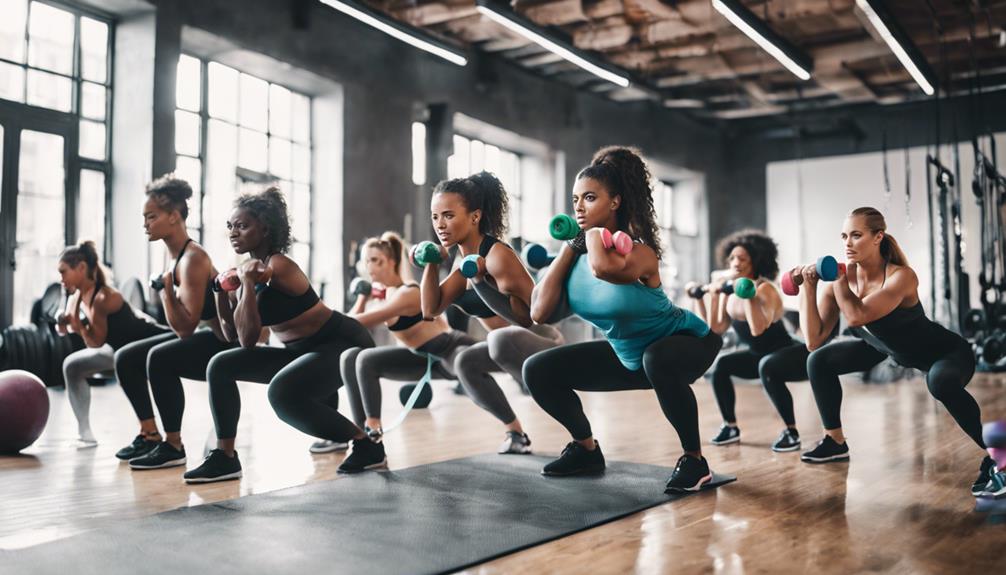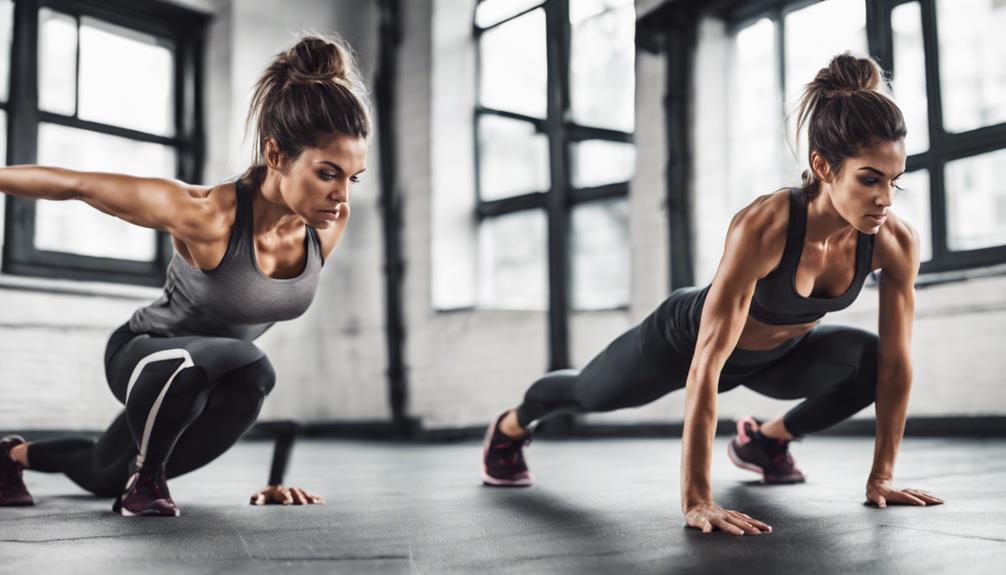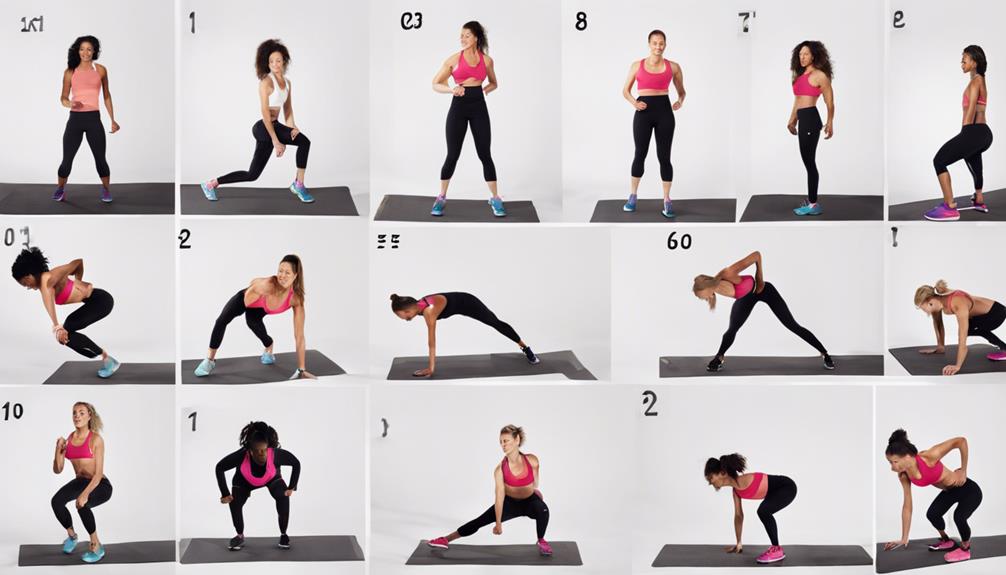The Best Workouts for Women to Build Strength and Flexibility
If you're looking to enhance your strength and flexibility as a woman, incorporating a variety of workout styles into your routine can yield significant benefits. From resistance training and Pilates to bodyweight exercises, yoga flows, and HIIT, each form of exercise offers unique advantages that cater to different aspects of your fitness goals. By blending these diverse workouts, you can create a comprehensive training regimen that targets various muscle groups while promoting overall flexibility and strength. Whether you're a beginner or seasoned fitness enthusiast, discovering the best combination of exercises tailored to your needs can be key to achieving your desired results.
Resistance Training
Curious about how to incorporate resistance training into your workout routine to enhance strength and flexibility? Resistance training offers a myriad of benefits, including increased muscle strength, improved bone density, enhanced metabolism, and a more toned physique. To maximize these benefits, it's crucial to maintain proper form during resistance exercises.
When engaging in resistance training, ensure that you start with a weight or resistance level that challenges you but still allows for proper execution of the exercise. Focus on controlled movements, emphasizing both the lifting and lowering phases. This not only reduces the risk of injury but also ensures that you target the intended muscle groups effectively.
Remember to breathe consistently throughout each repetition and avoid holding your breath.
Additionally, maintaining good posture and alignment is key to preventing strain on your muscles and joints. By prioritizing proper form in your resistance training routine, you can optimize your workouts for improved strength and flexibility.
Pilates
When looking to further enhance your strength and flexibility, incorporating Pilates into your workout routine can be a highly effective addition. Pilates focuses on core stability, helping you build a strong foundation that supports overall strength and flexibility. One of the key benefits of Pilates is its emphasis on the mind-body connection, encouraging you to be present and mindful during each movement.
By engaging your core muscles in every exercise, Pilates helps improve your posture, balance, and coordination. The controlled movements in Pilates not only target specific muscle groups but also promote overall body awareness. This mind-body connection can lead to increased relaxation, reduced stress levels, and improved mental clarity.
Whether you're a beginner or have been practicing Pilates for a while, the diverse range of exercises can be tailored to suit your fitness level and goals. Incorporating Pilates into your routine can help you achieve a well-rounded workout that enhances both strength and flexibility effectively.
Bodyweight Exercises
Bodyweight exercises are a versatile and effective way to improve your strength and flexibility without the need for equipment. These exercises engage multiple muscle groups simultaneously, making them great for building overall strength and stability. When focusing on bodyweight exercises, it's essential to prioritize movements that enhance core strength and mobility.
Core strength is crucial for maintaining proper posture, preventing injuries, and improving athletic performance. Exercises like planks, mountain climbers, and Russian twists target your core muscles, helping you develop a strong and stable midsection.
Incorporating mobility exercises into your bodyweight workout routine can improve your range of motion, joint health, and overall flexibility. Movements such as hip circles, shoulder rotations, and leg swings can help increase your mobility and reduce the risk of muscle imbalances.
Yoga Flows
To further enhance your strength, flexibility, and overall well-being, incorporating yoga flows into your workout routine can be incredibly beneficial. Yoga flows offer a unique combination of breath control and mind-body connection that can help you build physical and mental strength. By focusing on your breath during each movement, you can improve your lung capacity and oxygen flow, enhancing your endurance. The mind-body connection in yoga flows allows you to be present in the moment, improving your concentration and reducing stress levels.
Yoga flows typically involve a series of poses that flow seamlessly from one to the next, promoting flexibility and balance. These fluid movements engage various muscle groups, helping you build strength and tone your body. Additionally, the emphasis on alignment in yoga flows can improve your posture and overall body awareness.
Incorporating yoga flows into your fitness routine can't only help you achieve your strength and flexibility goals but also provide a sense of calm and relaxation in your daily life.
High-Intensity Interval Training (HIIT)
For an effective and time-efficient workout regimen, consider incorporating High-Intensity Interval Training (HIIT) into your fitness routine. HIIT involves short bursts of intense exercise followed by brief recovery periods, making it a fantastic cardio option that can help boost your metabolism and improve cardiovascular health. This form of training is known to be particularly effective for women looking to build strength and flexibility while burning calories efficiently.
To maximize the benefits of HIIT, it's crucial to focus on proper recovery techniques. Adequate rest, hydration, and nutrition are essential for allowing your muscles to repair and grow stronger after intense workouts.
Incorporating stretching exercises and foam rolling into your post-HIIT routine can also help prevent injury and improve flexibility.
Frequently Asked Questions
Can I Incorporate These Workouts Into My Postpartum Fitness Routine Safely?
You can safely incorporate these workouts into your postpartum fitness routine by making postpartum modifications and progressing gradually. Listen to your body, prioritize core and pelvic floor strength, and consult with a fitness professional for personalized guidance.
How Can I Prevent Muscle Soreness After These Workouts?
You're determined to crush those workouts, but muscle soreness got you feeling like you wrestled a bear. Try foam rolling, gentle stretching, stay hydrated, and nail those recovery techniques. Your muscles will thank you later!
Are There Modifications for These Exercises if I Have a Knee Injury?
If you have a knee injury, there are injury modifications available for exercises. Focus on strength training while considering your knee's limitations. Consult a professional to tailor workouts for your needs, ensuring safety and effectiveness.
What Should I Eat Before and After These Workouts for Optimal Results?
Before your workout, opt for a light snack like a banana or yogurt for energy. Post-workout, refuel with a balanced meal rich in protein and carbs. Stay hydrated throughout and consider supplements based on your specific needs for optimal results.
Can These Workouts Help Improve My Posture and Alleviate Back Pain?
Improving posture and alleviating back pain are common benefits of these workouts. Yoga enhances alignment and flexibility, aiding in posture correction. Strengthening your core provides stability, supporting your back and reducing discomfort. Consistent practice can make a noticeable difference.
Conclusion
Incorporating a variety of workouts like resistance training, Pilates, bodyweight exercises, yoga flows, and HIIT into your routine can sculpt a strong and flexible body. Just like a well-balanced recipe, each workout adds its unique flavor to the mix, creating a harmonious blend of strength and flexibility. So, lace up your sneakers, roll out your mat, and get ready to transform your body with a diverse and effective fitness routine.












